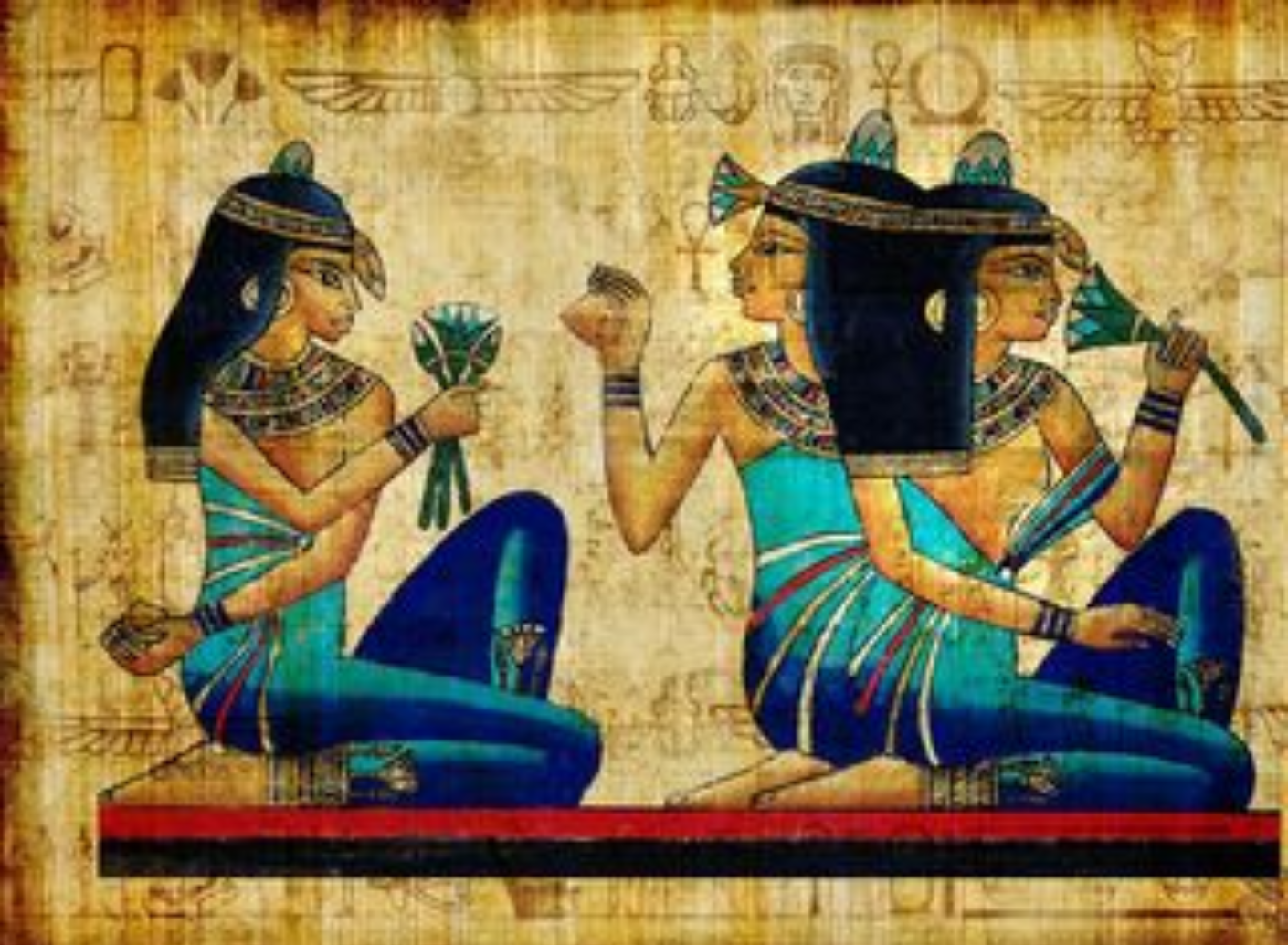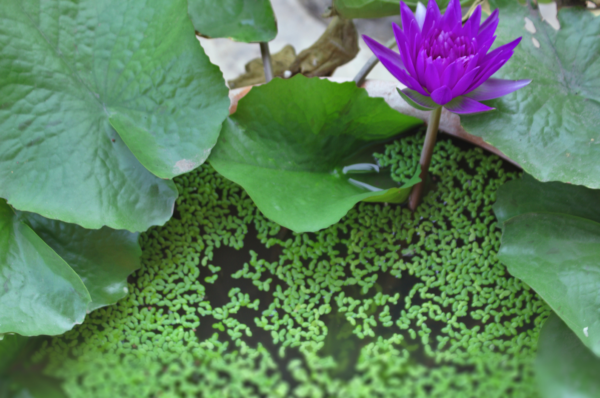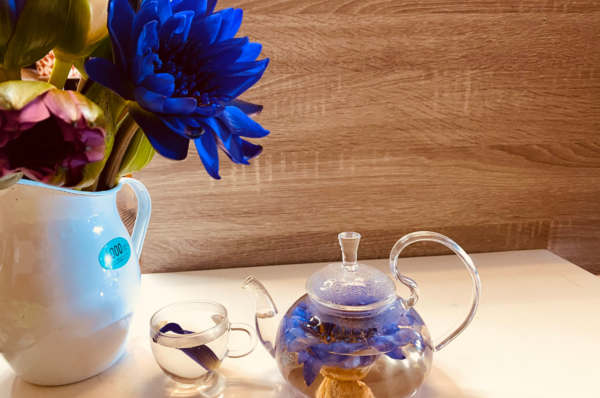In the annals of history, certain botanical wonders have captivated civilizations with their beauty, mystical allure, and potential therapeutic benefits. Among these, the Blue Lotus Flower (Nymphaea Caerulea) stands as an enchanting symbol that has left an indelible mark on the tapestry of human culture. In this article, we delve into the fascinating history of the Blue Lotus Flower, tracing its journey through ancient civilizations and its enduring legacy in the modern world.
Ancient Egypt…
The Blue Lotus Flower is perhaps most famous for its association with ancient Egypt, where it was considered a sacred and divine symbol. Depictions of the flower can be found in numerous ancient Egyptian artifacts, hieroglyphics, and temple carvings. It was closely linked to the sun god Ra and the goddess of love and fertility, Hathor. The flower represented creation, rebirth, and the cycle of life and death, aligning with the Nile’s seasonal flooding and renewal of the land. The ancient Egyptians also believed that the flower possessed the power to induce altered states of consciousness and spiritual insights, making it a central element in religious ceremonies, rituals, and festivities.
Symbol of Creation and Rebirth:
The Blue Lotus Flower was revered as a symbol of creation and rebirth. Its association with the sun god Ra, who represented the sun’s cycle from rising to setting, mirrored the lotus’s daily cycle of blooming in the morning and closing at night. This parallel highlighted the idea of eternal renewal and the cyclical nature of life, death, and resurrection.
Goddess Hathor and Love:
The goddess Hathor, who personified love, joy, and beauty, was closely associated with the Blue Lotus Flower. She was considered the embodiment of the divine feminine and played a vital role in fertility and motherhood. The flower’s link to Hathor further emphasized its association with love and procreation.
Ritual and Ceremonial Use:
The ancient Egyptians integrated the Blue Lotus Flower into their religious ceremonies, rituals, and festivities. It was often used in temple offerings and as a ceremonial adornment. The flower’s enchanting fragrance and visual beauty added a sense of sacredness to these spiritual practices.
Altered States of Consciousness:
One of the most intriguing aspects of the Blue Lotus Flower in ancient Egypt was its reputation for inducing altered states of consciousness. It was believed to have psychoactive properties, and its consumption was considered a means of connecting with the divine and gaining spiritual insights.
Healing and Medicinal Uses:
In addition to its spiritual significance, the Blue Lotus Flower was also valued for its medicinal properties. Ancient Egyptian physicians and healers used the flower in various remedies and potions for its potential therapeutic benefits.
Artistic and Symbolic Representation:
Artisans and craftsmen in ancient Egypt depicted the Blue Lotus Flower in their artwork, pottery, and jewelry. Its symbolic representation in these creations further solidified its importance in daily life and cultural beliefs.
Ancient Mesopotamia:
The Blue Lotus Flower’s significance extended beyond Egypt, as evidence of its use and cultural significance has been found in ancient Mesopotamian civilizations. Clay tablets dating back to around 2000 BCE mention the flower, indicating its presence in the region’s religious and cultural practices.
Mention in Cuneiform Tablets:
Clay tablets dating back to around 2000 BCE have been discovered in the region of Mesopotamia, which includes modern-day Iraq, parts of Iran, Syria, and Turkey. These tablets contain cuneiform inscriptions, an ancient writing system used by the Mesopotamians. Among these inscriptions, references to the Blue Lotus Flower have been found, indicating its familiarity and cultural significance in the region.
Association with Healing and Medicine:
The Blue Lotus Flower was noted for its potential healing properties in ancient Mesopotamia. It was often used as a herbal remedy in traditional medicine, and its preparations were employed to alleviate various ailments and promote well-being.
Religious and Spiritual Significance:
Similar to its role in ancient Egypt, the Blue Lotus Flower held religious and spiritual significance in Mesopotamia as well. It might have been associated with deities or featured in religious ceremonies and rituals, though specific details about its exact role in their belief system are not as well-documented as in ancient Egypt.
Trade and Cultural Exchange:
Mesopotamia was a vibrant hub of trade and cultural exchange in ancient times, with interactions between various civilizations from different regions. As a result, the Blue Lotus Flower’s presence might have been influenced by trade and cultural diffusion, making it a part of the broader tapestry of cultural exchange in the region.
Ephemeral References:
While the Blue Lotus Flower’s presence in ancient Mesopotamia is attested in some cuneiform tablets, the references to the flower are not as abundant or detailed as those in ancient Egypt. As a result, its exact role and significance in Mesopotamian culture remain somewhat elusive, and further research and archaeological discoveries may shed more light on its place in their society.
Ancient India…
In ancient India, the Blue Lotus Flower, known as the “Kamal” or “Nilotpala,” held a special place in the hearts of its people, leaving an indelible mark on their art, literature, and spiritual beliefs. Here’s a glimpse into the significance of the Blue Lotus Flower in ancient Indian culture:
Symbol of Purity and Spiritual Awakening:
In Hindu mythology, the lotus holds profound symbolism and spiritual significance. The Blue Lotus Flower, with its exquisite beauty and vibrant blue hue, became a symbol of purity, spiritual awakening, and enlightenment. The unfolding petals of the lotus symbolized the soul’s journey towards self-realization and liberation.
Associations with Deities:
The Blue Lotus Flower was associated with various deities in Hinduism. For instance, Lord Vishnu, one of the principal deities in the Hindu pantheon, is often depicted resting on a celestial serpent named Shesha with a Blue Lotus Flower in his hand. The lotus signified his divine purity and transcendence. Similarly, Goddess Lakshmi, the goddess of wealth, beauty, and prosperity, is also linked to the lotus, symbolizing her grace and abundance.
Spiritual Practices and Rituals:
In addition to its symbolic importance, the Blue Lotus Flower might have been used in spiritual practices and rituals in ancient India, though specific details are not as extensively recorded as in Egypt. Its association with purity and spiritual enlightenment likely made it an attractive choice for ceremonial offerings and as an emblem of divine presence.
Beauty and Aesthetics:
The Blue Lotus Flower’s allure extended to Indian art and literature. It featured in poetry, music, and dance, serving as an inspiration for creative expression and evoking feelings of beauty and divinity. The flower’s vivid blue color captured the imagination of artists and poets, becoming a recurring motif in their works.
Connection to Nature and Water Bodies:
The Blue Lotus Flower’s presence in India might have also been influenced by its natural habitat in ponds, lakes, and other water bodies. Its presence in these natural settings could have further added to its mystique and cultural significance.
Other Cultures…
Indeed, the influence of the Blue Lotus Flower (Nymphaea Caerulea) extended far beyond the borders of ancient Egypt, Mesopotamia, and India. As a result of trade and cultural interactions along ancient trade routes, the flower’s reputation for beauty, spiritual significance, and healing properties spread to various other civilizations, including ancient Greece and Rome. Here’s how the Blue Lotus Flower left its mark in these cultures:
Ancient Greece:
The ancient Greeks, renowned for their appreciation of aesthetics and nature’s beauty, were introduced to the allure of the Blue Lotus Flower through trade and cultural exchanges. While it might not have played as prominent a role in Greek mythology as in Egyptian or Indian myths, it was admired for its captivating appearance and associations with divinity and spirituality. The flower’s striking blue color and enchanting fragrance likely captivated the hearts of the ancient Greeks, who esteemed it as a symbol of beauty and grace.
Ancient Rome:
Following the trade routes and cultural exchanges, the Blue Lotus Flower found its way to ancient Rome. Like the Greeks, the Romans had an affinity for beautiful flora and fauna. While there are no extensive records of the flower’s specific significance in Roman culture or religion, it is likely that it was cherished for its aesthetic appeal and healing properties.
Herbal and Medicinal Uses:
In addition to its symbolic and cultural value, the Blue Lotus Flower’s healing properties might have been recognized and utilized in ancient Greece and Rome. Just like in Egypt and Mesopotamia, the flower might have been employed in traditional herbal remedies and natural medicines to address various ailments.
Symbol of Exoticism:
The flower’s fame as a sacred and treasured flower in the ancient civilizations of Egypt and India likely added to its allure in the eyes of the ancient Greeks and Romans. The Blue Lotus Flower might have been viewed as an exotic and esteemed plant from distant lands, elevating its status as a precious and highly valued botanical treasure.
While the specific roles and cultural significance of the Blue Lotus Flower in ancient Greece and Rome might not be as extensively documented as in its primary regions of influence, its presence and allure in these civilizations speak to its enduring impact on ancient cultures worldwide. Today, the flower continues to be a symbol of beauty, spirituality, and historical connection, reflecting the universal appeal of nature’s wonders across time and geography.
Rediscovery In Modern Times…
The modern rediscovery of the Blue Lotus Flower (Nymphaea caerulea) was a pivotal moment that brought ancient wisdom and cultural significance back into the spotlight. During the 19th and 20th centuries, the flower’s importance in ancient civilizations such as Egypt, Mesopotamia, and India was revisited by archaeologists and historians, leading to renewed interest and exploration in its psychoactive and medicinal properties. Here’s how this rediscovery unfolded and its impact on modern research and exploration:
Archaeological Discoveries:
Archaeological expeditions in Egypt, Mesopotamia, and other regions unveiled a wealth of artifacts, inscriptions, and historical texts that provided valuable insights into the cultural significance of the Blue Lotus Flower in ancient times. These discoveries shed light on its roles in religious practices, rituals, and spiritual beliefs, sparking curiosity among researchers.
Revival of Interest:
The rediscovery of the Blue Lotus Flower’s cultural and spiritual importance ignited a revival of interest in ancient traditions and herbal knowledge. Enthusiasts, researchers, and historians alike sought to understand the flower’s historical context and its relevance to contemporary culture.
Investigation of Psychoactive Properties:
With references to the Blue Lotus Flower’s potential psychoactive properties in ancient texts, researchers began exploring its chemical composition and effects on the human mind. Studies were conducted to analyze the presence of psychoactive alkaloids, such as nuciferine and aporphine, which were believed to contribute to its reported effects.
Medicinal Potential:
The ancient use of the Blue Lotus Flower in traditional medicine also piqued the interest of researchers in modern times. Investigations were undertaken to explore its potential medicinal benefits and therapeutic applications, aligning with the growing interest in natural remedies and herbal medicines.
Ethnobotanical and Cultural Studies:
The flower’s rediscovery spurred ethnobotanical studies, focusing on its cultural significance and traditional uses among indigenous communities. Researchers sought to understand how the flower continued to be valued and utilized in different cultures and its place in contemporary rituals and practices.
Contemporary Applications:
As the knowledge of the Blue Lotus Flower’s historical significance and potential properties spread, it found a place among modern herbal enthusiasts, spiritual seekers, and those interested in exploring natural alternatives for relaxation, mood enhancement, and wellness.
Contemporary Uses…
Contemporary uses of the Blue Lotus Flower (Nymphaea Caerulea) have been shaped by its rich historical significance and its potential effects on the mind and body. Here’s a closer look at how the flower continues to captivate and be embraced by various communities in modern times:
Mood Enhancement and Relaxation:
One of the primary reasons for the Blue Lotus Flower’s popularity in modern herbal circles is its potential mood-enhancing and relaxing properties. Many users report experiencing a sense of calm, tranquility, and mild euphoria after consuming the flower or its extracts. As a result, it is often sought after as a natural remedy to alleviate stress, anxiety, and tension.
Sleep Aid:
The Blue Lotus Flower’s relaxing effects extend to its potential to support better sleep quality. Some individuals use the flower to aid in sleep-related issues, such as insomnia or difficulty falling asleep. It is often consumed in the form of tea or herbal preparations before bedtime to promote relaxation and improve sleep.
Mindfulness and Meditation:
The flower’s association with ancient spiritual practices, particularly in Egypt and India, has led to its incorporation into mindfulness and meditation practices in modern times. Some practitioners use the Blue Lotus Flower to enhance their meditation experience, fostering a sense of tranquility and spiritual connection.
Herbal Teas and Infusions:
Blue Lotus Flower is commonly brewed into herbal teas and infusions. The tea is prepared by steeping dried petals or other parts of the flower in hot water. The resulting beverage is enjoyed for its delicate floral flavor and potential therapeutic effects.
Tinctures and Extracts:
Blue Lotus Flower tinctures and extracts are also available in the market. These concentrated forms allow for precise dosing and are often used for their potential mood-enhancing and relaxing properties.
Artistic and Creative Inspiration:
The flower’s timeless beauty and symbolism continue to inspire artists, writers, and musicians worldwide. Its visual appeal and historical significance serve as creative muses, sparking artistic expression in various forms of art.
Ethnobotanical and Cultural Interest:
The Blue Lotus Flower has drawn the attention of ethnobotanists and cultural enthusiasts, as they explore its place in contemporary rituals and practices among different cultures and communities.





